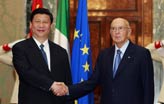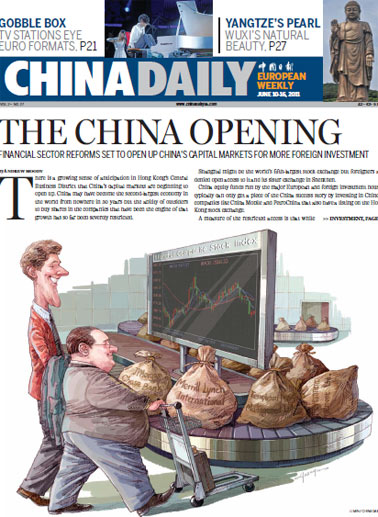From made in China to invented in China
Updated: 2011-06-10 10:44
By Mike Bastin (China Daily European Weekly)
|
 |
While China, the Chinese and the Chinese economy continue to dominate the airwaves over the past few years, it is the emergence of Chinese brands that now grabs headlines. Take as just one example among many, the recent annual BrandZ survey produced by Millward Brown in which no less than 12 Chinese brands found themselves in the top 100 most valuable global brands and more than half of this year's newcomers were Chinese brands.
Over the next few years, we will witness the rapid emergence and increasing strength of Chinese brands on the world stage. These Chinese brands will come from a wide variety of industries, including clothing (such as MetersBonWe and VANCL), banking (such as Bank of China) and computers (such as Lenovo).
Consumer behavior
We must never forget that consumers drive brand performance, nothing else. Chinese consumers are changing and it is Chinese companies that are best placed to take advantage of this over the long term.
While many Chinese brands dominate their domestic market, from computers (Lenovo) and household appliances (Haier) to sport and fashion brands (Li-Ning, MetersBonWe, VANCL), there are major changes taking place within Chinese society that will continue to influence brand consumption. Some of the most important changes in Chinese consumerism are:
Chinese consumers value hedonic shopping more than their Western counterparts: Perhaps this is because shopping as a leisure activity is still relatively new for the Chinese.
Chinese consumers value social interaction when shopping. Aspects of traditional Chinese culture remain firmly rooted deep within even the youngest, most modern Chinese consumers. Perhaps this is why the shopping experience has become a major opportunity for maintaining and even finding friendship. Some of my recent research findings even suggest that Chinese shoppers view the shopping trip as an opportunity to "gain face". They value any praise or compliments received, and not just by their friends but also by shop assistants.
Chinese consumers value product and in-store interaction more. Chinese shoppers appreciate the importance of "touch" and "feel" when sampling possible purchases. Trust is a huge issue in China, one reason why well-known brands do so well and Chinese consumers are so brand conscious.
Chinese consumers value social status. This is most firmly rooted in Chinese history. Status, authority and power are perhaps the main drivers behind most Chinese consumer behavior. Shopping trips, therefore, are often the result of the need to increase social status with the purchase of what are to considered to be prestigious, exclusive brands.
International expansion
To achieve sustainable competitive advantage outside China, especially in the more mature European and United States markets, both price premium and value added are necessary, where value added takes time. At present even the most successful international Chinese brands, such as Lenovo, Haier, ZTE and Huawei, are behind. Strong international competition represents a major challenge for Chinese brands, but so does the lack of any clear brand-oriented culture within many Chinese firms. Strategy within Chinese companies remains focused on short-term sales and production and distribution efficiency and often lacks the sustained investment levels required to establish a dominant brand. Hierarchical organizational structures and centralization of decision-making also inhibit any transition toward a more dynamic, market-oriented organizational culture within many Chinese firms.
In order to instigate any change toward a brand-oriented culture, Chinese firms could consider the creation of a new, senior strategic brand manager role. Such a position will not only facilitate a more brand-oriented approach, but will also allow for professional brand management throughout the organization. This position will of course be filled by an internationally experienced brand manager and will also sit outside any marketing department so that marketing communications does not dominate any brand-building activity. Brand building rests on product quality, not creative advertising or other catchy forms of communication.
Currently, Chinese firms also lack entrepreneurial thinking and innovation, which are both at the heart of modern day business and brand building. Younger Chinese generations, such as balinghou (those born after 1980) and jiulinghou (those born after 1990), may contribute to change, and perhaps within only a few years. Such an anachronistic business culture does not exist in smaller, younger Chinese companies, such as clothing brands VANCL and MetersBonWe, where an exciting, adventurous attitude appears in place. However, right now these Chinese companies lack the size and resources to launch any global expansion.
Perhaps many Chinese brands, those dominant across China such as Li-Ning, Haier and Lenovo, are in fact victims of their own success. The Chinese market requires large-scale production and efficient distribution which often lead to commoditization and little differentiation. This business model works in China. In contrast, the US and European brands have been forced to seek international markets far sooner than their Chinese counterparts due to much smaller home country opportunities. While Chinese companies have invested in order to achieve success across China, it is not investment channeled into research and new product development but investment into production and distribution efficiency only.
International activity
At first many Chinese companies sought to penetrate markets in Southeast Asia, the Middle East and increasingly Africa. Markets where price competitiveness remains most important. This should not be seen as an acceptance among Chinese companies that they cannot compete in the more lucrative but fiercely competitive markets of North America and Europe. Instead it is often due to good political relationships enjoyed over many years between China and countries in these areas. Chinese companies should use this success as a springboard into the US and European markets.
The Chinese companies which have penetrated the US and Europe most are easily Haier and Lenovo. These companies, however, are still not that well-known with relatively low-brand awareness levels. Both have an excellent platform but need to step forward very carefully. Lenovo's recent acquisition of German PC maker Medion marks another step forward in their international expansion and growth by acquisition appears to be a key part of their strategy. The benefits of this approach are clear but so are the potential pitfalls. Lenovo, and Geely with last year's acquisition of the Volvo car brand, need to manage post-acquisition integration very carefully and ensure that technology transfer in particular takes place seamlessly. Haier, on the other hand, appear to favor organic growth with no major cross-border acquisitions so far. This does not carry the risks of growth by acquisition but lacks speed and the ability to move opportunistically.
The emergence of brand
Until very recently, China's reputation as a place for low-cost production and efficient distribution overshadowed any progress made by Chinese companies and their brands. Ironically, however, it is this intensity of manufacturing other company's brands that has enabled Chinese producers to learn quickly about brand building, hence the rapid emergence of "brand China", a place where innovation and creativity are now spreading exponentially.
Such a move from "made in China" to "invented in China" should come as no surprise given China's unique and marvelous 5,000-year history. Ancient China led the world many times and is replete with groundbreaking invention and innovation, such as the "five great inventions". Modern day examples of China "leading the world" include BYD's pioneering work with electric cars and the completion of more and more high-speed trains (the fastest in the world).
That this emergence will continue is beyond doubt, the issue is how and how quickly? Chinese history can also contribute here. China's huge number of festivals, for example the recent Dragon Boat Festival, as well as famous landmarks and rivers and mountains offer an excellent brand association opportunity. An opportunity that other countries do not have.
Other factor that should further accelerate the growth of branding are:
The emergence of second- and third-tier cities and brand opportunities. More Chinese consumers are becoming brand conscious in second and third-tier cities. Not only it is purchasing power spreading across these cities, but it is clear that consumers in these areas are even more brand conscious than those in first-tier cities. Second- and third-tier city consumers also appear to be more loyal to Chinese brands.
The perception of the Chinese brand is changing. All aspects of brand building have improved immensely among many Chinese companies, from product quality to more creative, emotional advertising and packaging, such as Li-Ning.
The Chinese economy remains robust. Despite uncertainty remaining in the US with high unemployment and Europe with debt crisis among many member states, China stands out as a strong and stable economy with continued growth prospects.
The emergence of the Chinese entrepreneur. Primarily among younger generations there is a discernible shift in social and cultural values from conservative, shy and task-oriented to outgoing, innovative and ambitious. This cultural change, perhaps more than any other factor, will propel "brand China" higher and higher.
The author is visiting professor of brand management at China Agricultural University and teaches marketing and management at Tsinghua University.
E-paper

Harbin-ger of change
Old industrial center looks to innovation to move up the value chain
Preview of the coming issue
Chemical attraction
The reel Mao
Specials

Vice-President visits Italy
The visit is expected to lend new impetus to Sino-Italian relations.

Birthday a new 'starting point'
China's national English language newspaper aims for a top-notch international all-media group.

Sky is the limit
Chinese tycoon conjures up green dreams in Europe with solar panels
